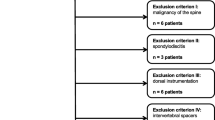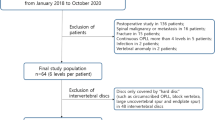Abstract
Objectives
To evaluate the diagnostic accuracy of multidetector CT (MDCT) for detection of lumbar disc herniation with MRI as standard of reference.
Methods
Patients with low back pain underwent indicated MDCT (128-row MDCT, helical pitch), 60 patients with iterative reconstruction (IR) and 67 patients with filtered back projection (FBP). Lumbar spine MRI (1.5 T) was performed within 1 month. Signal-to-noise ratios (SNR) of cerebrospinal fluid (CSF), annulus fibrosus (AF) and the spinal cord (SC) were determined for all modalities. Two readers independently rated image quality (IQ), diagnostic confidence and accuracy in the diagnosis of lumbar disc herniation using MRI as standard of reference. Inter-reader correlation was assessed with weighted κ.
Results
Sensitivity, specificity, precision and accuracy of MDCT for disc protrusion were 98.8%, 96.5%, 97.1%, 97.8% (disc level), 97.7%, 92.9%, 98.6%, 96.9% (patient level). SNR of IR was significantly higher than FBP. IQ was significantly better in IR owing to visually reduced noise and improved delineation of the discs. κ (>0.90) was excellent for both algorithms.
Conclusion
MDCT of the lumbar spine yields high diagnostic accuracy for detection of lumbar disc herniation. IR improves image quality so that the provided diagnostic accuracy is principally equivalent to MRI.
Key Points
• MDCT is an accurate alternative to MRI in disc herniation diagnosis.
• By IR enhanced image quality improves MDCT diagnostic confidence similar to MRI.
• Advances in CT technology contribute to improved diagnostic performance in lumbar spine imaging.






Similar content being viewed by others
References
Burton AK, Balague F, Cardon G et al (2006) Chapter 2. European guidelines for prevention in low back pain: November 2004. Eur Spine J 15(Suppl 2):S136–168
Saleem S, Aslam HM, Rehmani MA, Raees A, Alvi AA, Ashraf J (2013) Lumbar disc degenerative disease: disc degeneration symptoms and magnetic resonance image findings. Asian Spine J 7:322–334
Chou R, Qaseem A, Snow V et al (2007) Diagnosis and treatment of low back pain: a joint clinical practice guideline from the American College of Physicians and the American Pain Society. Ann Intern Med 147:478–491
Airaksinen O, Brox JI, Cedraschi C et al (2006) Chapter 4. European guidelines for the management of chronic nonspecific low back pain. Eur Spine J 15(Suppl 2):S192–300
van Rijn RM, Wassenaar M, Verhagen AP et al (2012) Computed tomography for the diagnosis of lumbar spinal pathology in adult patients with low back pain or sciatica: a diagnostic systematic review. Eur Spine J 21:228–239
Jackson RP, Cain JE, Jacobs RR, Cooper BR, McManus GE (1989) Neuroradiographic diagnosis of lumbar herniated nucleus pulposis: II. A comparison of computed tomography (CT), myelography, CT-myelography, and magnetic resonance imaging. Spine 14:1362–1367
Winklehner A, Karlo C, Puippe G et al (2011) Raw data-based iterative reconstruction in body CTA: evaluation of radiation dose saving potential. Eur Radiol 21:2521–2526
Morsbach F, Desbiolles L, Raupach R, Leschka S, Schmidt B, Alkadhi H (2016) Noise texture deviation: a measure for quantifying artifacts in computed tomography images with iterative reconstructions. Investig Radiol. doi:10.1097/RLI.0000000000000312
Becce F, Salah YB, Verdun FR et al (2013) Computed tomography of the cervical spine: comparison of image quality between a standard-dose and a low-dose protocol using filtered back-projection and iterative reconstruction. Skelet Radiol 42:937–945
Deak PD, Smal Y, Kalender WA (2010) Multisection CT protocols: sex- and age-specific conversion factors used to determine effective dose from dose-length product. Radiology 257:158–166
ICRP (2007) The 2007 recommendations of the International Commission on Radiological Protection. ICRP Publication 103, Ann ICRP 37
Magnotta VA, Friedman L (2006) Measurement of signal-to-noise and contrast-to-noise in the fBIRN multicenter imaging study. J Digit Imaging 19:140–147
Wildermuth S, Zanetti M, Duewell S et al (1998) Lumbar spine: quantitative and qualitative assessment of positional (upright flexion and extension) MR imaging and myelography. Radiology 207:391–398
Park HJ, Kim SS, Lee SY et al (2012) Clinical correlation of a new MR imaging method for assessing lumbar foraminal stenosis. AJNR Am J Neuroradiol 33:818–822
Mantatzis M, Kakolyris S, Amarantidis K, Karayiannakis A, Prassopoulos P (2009) Treatment response classification of liver metastatic disease evaluated on imaging. Are RECIST unidimensional measurements accurate? Eur Radiol 19:1809–1816
Beculic H, Skomorac R, Jusic A et al (2016) Impact of timing on surgical outcome in patients with cauda equina syndrome caused by lumbar disc herniation. Med Glas (Zenica) 13:136–141
Small SA, Perron AD, Brady WJ (2005) Orthopedic pitfalls: cauda equina syndrome. Am J Emerg Med 23:159–163
Lavy C, James A, Wilson-MacDonald J, Fairbank J (2009) Cauda equina syndrome. BMJ 338:b936
Hu H, He H, Foley W, Fox S (2000) Four multidetector-row helical CT: image quality and volume coverage speed. Radiology 215:55–62
Chawla S (2004) Multidetector computed tomography imaging of the spine. J Comput Assist Tomogr 28:S28–S31
Geyer LL, Korner M, Hempel R et al (2013) Evaluation of a dedicated MDCT protocol using iterative image reconstruction after cervical spine trauma. Clin Radiol 68:e391–396
Deák Z, Grimm J, Treitl M et al (2013) Filtered back projection, adaptive statistical iterative reconstruction, and a model-based iterative reconstruction in abdominal CT: an experimental clinical study. Radiology 266:197–206
Katsura M, Sato J, Akahane M et al (2013) Comparison of pure and hybrid iterative reconstruction techniques with conventional filtered back projection: image quality assessment in the cervicothoracic region. Eur J Radiol 82:356–360
Silva AC, Lawder HJ, Hara A, Kujak J, Pavlicek W (2010) Innovations in CT dose reduction strategy: application of the adaptive statistical iterative reconstruction algorithm. AJR Am J Roentgenol 194:191–199
Bartynski WS, Lin L (2003) Lumbar root compression in the lateral recess: MR imaging, conventional myelography, and CT myelography comparison with surgical confirmation. Am J Neuroradiol 24:348–360
Notohamiprodjo S, Deak Z, Meurer F et al (2015) Image quality of iterative reconstruction in cranial CT imaging: comparison of model-based iterative reconstruction (MBIR) and adaptive statistical iterative reconstruction (ASiR). Eur Radiol 25:140–146
Gaddikeri S, Andre JB, Benjert J, Hippe DS, Anzai Y (2015) Impact of model-based iterative reconstruction on image quality of contrast-enhanced neck CT. AJNR Am J Neuroradiol 36:391–396
Katsura M, Matsuda I, Akahane M et al (2012) Model-based iterative reconstruction technique for radiation dose reduction in chest CT: comparison with the adaptive statistical iterative reconstruction technique. Eur Radiol 22:1613–1623
Nakamoto A, Kim T, Hori M et al (2015) Clinical evaluation of image quality and radiation dose reduction in upper abdominal computed tomography using model-based iterative reconstruction; comparison with filtered back projection and adaptive statistical iterative reconstruction. Eur J Radiol 84:1715–1723
Nishida J, Kitagawa K, Nagata M, Yamazaki A, Nagasawa N, Sakuma H (2013) Model-based iterative reconstruction for multi-detector row CT assessment of the Adamkiewicz artery. Radiology 270:282–291
Puchner SB, Ferencik M, Maurovich-Horvat P et al (2015) Iterative image reconstruction algorithms in coronary CT angiography improve the detection of lipid-core plaque—a comparison with histology. Eur Radiol 25:15–23
Yamada Y, Jinzaki M, Tanami Y et al (2012) Model-based iterative reconstruction technique for ultralow-dose computed tomography of the lung: a pilot study. Invesigt Radiol 47:482–489
Vardhanabhuti V, Riordan RD, Mitchell GR, Hyde C, Roobottom CA (2014) Image comparative assessment using iterative reconstructions: clinical comparison of low-dose abdominal/pelvic computed tomography between adaptive statistical, model-based iterative reconstructions and traditional filtered back projection in 65 patients. Investig Radiol 49:209–216
Acknowledgements
The scientific guarantor of this publication is Ms. Susan Notohamiprodjo. The authors of this manuscript declare no relationships with any companies whose products or services may be related to the subject matter of the article. The authors state that this work has not received any funding.
One of the authors has significant statistical expertise. Institutional review board approval was not required because of retrospective study design. Written informed consent was obtained from all subjects (patients) in this study. No study subjects or cohorts have been previously reported.
Methodology: retrospective, non-randomised controlled trial, performed at one institution.
Author information
Authors and Affiliations
Corresponding author
Rights and permissions
About this article
Cite this article
Notohamiprodjo, S., Stahl, R., Braunagel, M. et al. Diagnostic accuracy of contemporary multidetector computed tomography (MDCT) for the detection of lumbar disc herniation. Eur Radiol 27, 3443–3451 (2017). https://doi.org/10.1007/s00330-016-4686-7
Received:
Revised:
Accepted:
Published:
Issue Date:
DOI: https://doi.org/10.1007/s00330-016-4686-7




